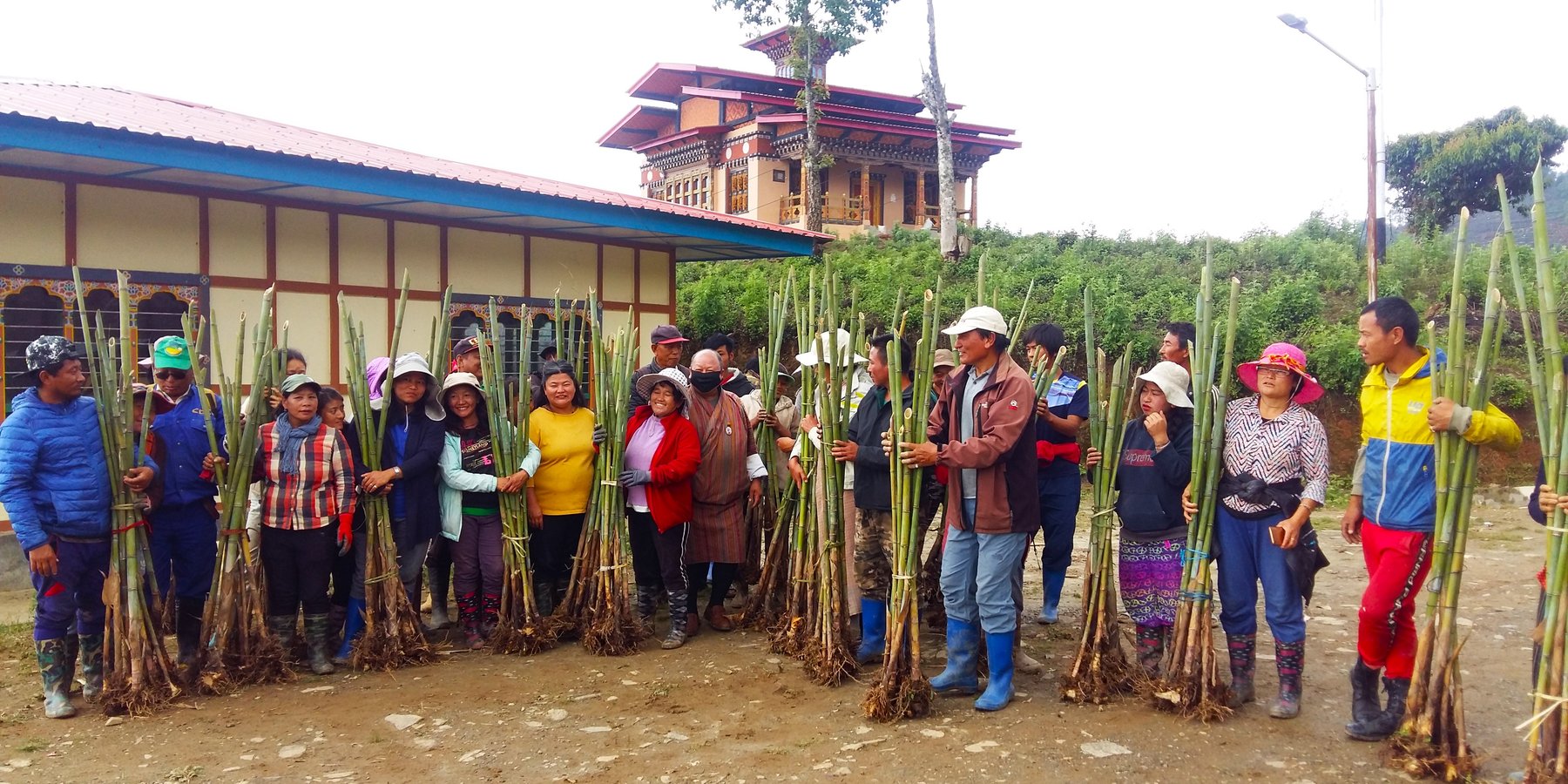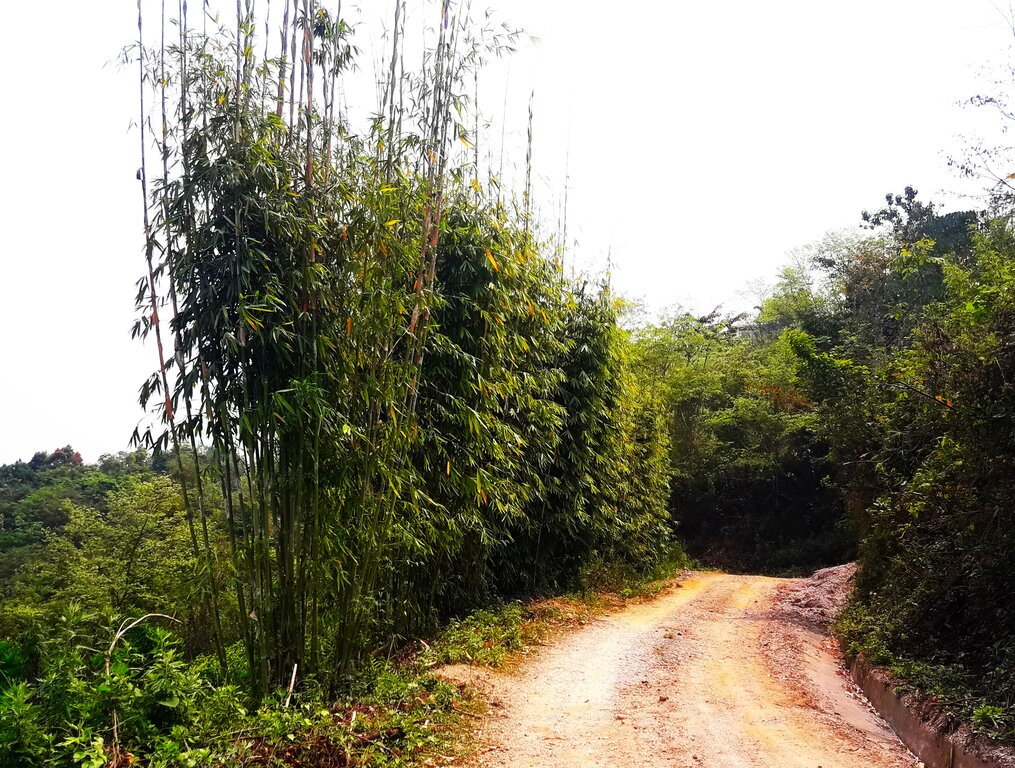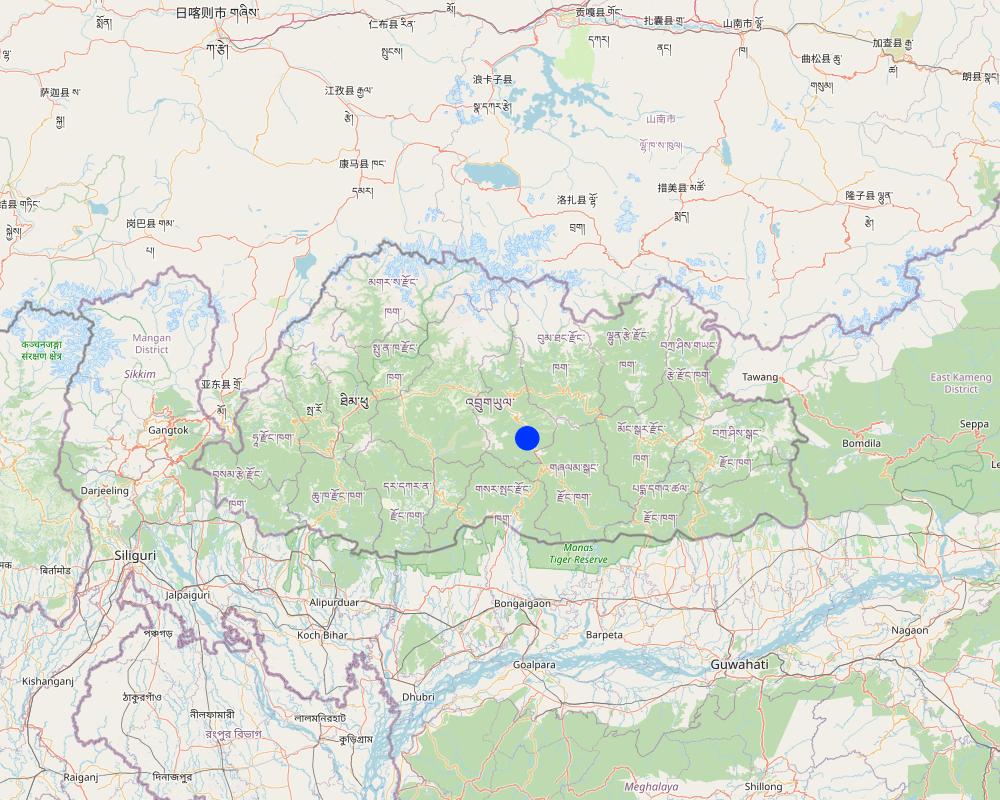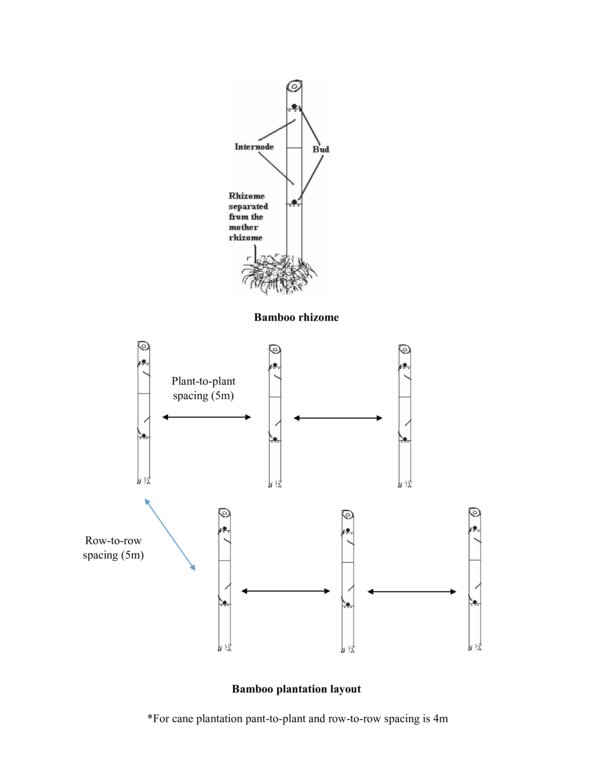Cane and Bamboo Plantation to Sustain Raw Materials [不丹]
- 创建:
- 更新:
- 编制者: Tshering Yangzom
- 编辑者: Tashi Wangdi
- 审查者: William Critchley, Rima Mekdaschi Studer, Joana Eichenberger
Ba Dang Pa Tshar Zuk Chong Bae Dhi Thoen Koed Yuen Ten Zho Ni (སྦ་དང་སྤ་ཚར་འཛུགས་སྐྱོང་འབད་དེ་ཐོན་སྐྱེད་ཡུན་བརྟན་བཟོ་ནི།)
technologies_6859 - 不丹
查看章节
全部展开 全部收起1. 一般信息
1.2 参与该技术评估和文件编制的资源人员和机构的联系方式
关键资源人
土地使用者:
Sonam
NA
不丹
土地使用者:
Nagari
NA
不丹
土地使用者:
Chencho
NA
不丹
土地使用者:
Lethro
NA
不丹
有助于对技术进行记录/评估的项目名称(如相关)
Strengthening national-level institutional and professional capacities of country Parties towards enhanced UNCCD monitoring and reporting – GEF 7 EA Umbrella II (GEF 7 UNCCD Enabling Activities_Umbrella II)有助于对技术进行记录/评估的机构名称(如相关)
National Soil Services Center, Department of Agric (National Soil Services Center, Department of Agric) - 不丹1.3 关于使用通过WOCAT记录的数据的条件
编制者和关键资源人员接受有关使用通过WOCAT记录数据的条件。:
是
1.4 所述技术的可持续性声明
这里所描述的技术在土地退化方面是否存在问题,导致无法被认为是一种可持续的土地管理技术?:
否
注释:
Bamboo and cane plantations help prevent land degradation. Bamboo and cane have extensive root systems that help prevent erosion, stabilize soil, and reduce landslide risks. They are excellent for revegetation as they quickly establish themselves. Bamboo and cane plantation is a sustainable land management technology.
1.5 参考关于SLM方法(使用WOCAT记录的SLM方法)的调查问卷
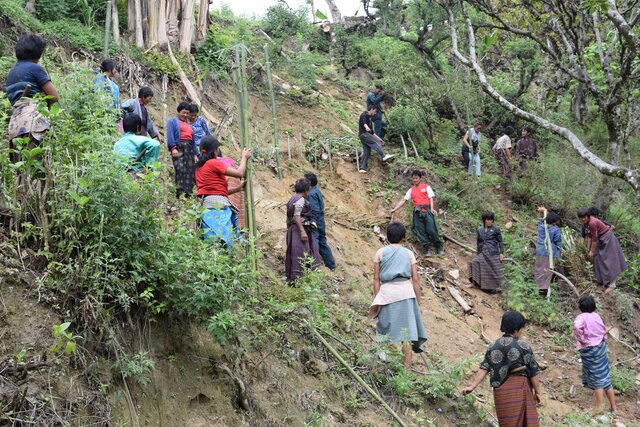
Community Forest Management Group [不丹]
The Community Forest Management Group (CFMG) functions with an aim to sustainably manage and utilize potential Non-Wood Forest Products (NWFP) such as cane and bamboo to diversify income sources. The Jangbi CFMG comprises three Monpa (indigenous) communities viz. Jangbi, Wangling and Phrumzur. The group's main mandates are to maintain raw …
- 编制者: Tshering Yangzom
2. SLM技术的说明
2.1 技术简介
技术定义:
Cane and bamboo plantations are managed by land users and indigenous communities to sustain these valuable raw materials for making handicraft items. Tsharzo (bamboo craft), is one of the main sources of income for land users. Tsharzo makes use of cane and bamboo to weave products such as backpacks, baskets (for winnowing, for carrying fodder, fruits, shoots, etc.), and mats. These plantations are effective in conserving land and water.
2.2 技术的详细说明
说明:
Tsharzo (bamboo craft), is one of the main sources of income, besides agriculture, for the land users of the Monpa community of Jangbi, Wangling, and Phrumzur in Trongsa. Tsharzo makes use of cane (“rattan”: Calamus spp.) and bamboo to weave products such as orongbhazib (backpacks), lapchu (hand baskets), chungchu (baskets), bechab (winnowing baskets), tsew (baskets to carry fodder, fruits, shoots etc.) and pari (mats). The technology of maintaining bamboo and cane plantations has been adopted by the land users to ensure a sustainable harvest of natural raw materials and to maintain germplasm for bamboo and cane. This helps to uphold ancestral arts and crafts skills, and to improve livelihoods.
Jangbi chiwog has 59 households (HH). The land users are members of Monpa Selwai Yoezer Tshogpa, a Community Forest Management Group which was formed to sustainably manage bamboo and cane resources, to preserve and promote age-old cane and bamboo handicraft skills and increase household income. The group is one of the most successful in promoting Tsharzo in the country. The group was formed under the United Nations Development Programme (UNDP) on 14 April 2000, and officially came into play in 2007, upon drafting bylaws. The bylaws were revised after the need for further improvement in the year 2018. The group received initial support from UNDP and Bhutan Orchids, a non-governmental organization (NGO). The government has given a total of 45 acres (18 ha) of land to the land users of Jangbi Chiwog to plant bamboo and cane. Out of the total, 15 acres (6 ha) are collectively managed as a nursery. About 10 acres (4 ha) are managed by each village as a plantation. The land users have planted three varieties of bamboo on the land.
The benefits of the technology include the establishment of dedicated germplasm for bamboo and cane, sustainable harvest of natural raw materials, conservation and promotion of ancestral arts and crafts skills, social cohesion through group formation, and employment opportunities.
Bamboo and cane plantations play a great role in preventing soil degradation. Bamboo and cane have extensive root systems that help prevent erosion, stabilize soil, and reduce landslide risks. They are excellent for revegetation as they quickly establish themselves. Bamboo is also an efficient carbon sink, absorbing significant amounts of carbon dioxide from the atmosphere. This helps mitigate climate change by reducing greenhouse gas concentrations. Bamboo and cane provide habitats for various organisms thereby increasing biodiversity. Products made from bamboo and cane are biodegradable, minimizing any potential environmental impact.
2.3 技术照片
2.5 已应用该技术的、本评估所涵盖的国家/地区/地点
国家:
不丹
区域/州/省:
Jangbi, Wangling and Phrumzur villages under Jangbi Chiwog, Langthel gewog, Trongsa Dzongkhag
具体说明该技术的分布:
- 均匀地分布在一个区域
如果技术均匀分布在一个区域,则指定覆盖的区域(单位为平方千米):
18.2
技术现场是否位于永久保护区?:
是
如果是,请具体说明:
The area falls under Jigme Singye Wangchuk National Park (JSWNP), Department of Forests and Park Services. The park is the third largest protected area in Bhutan, harbouring several globally threatened wildlife species.
Map
×2.6 实施日期
注明实施年份:
2000
2.7 技术介绍
详细说明该技术是如何引入的:
- 通过土地使用者的创新
- 通过项目/外部干预
注释(项目类型等):
The bamboo and cane plantation began through the formation of the group, Monpa Selwai Yoezer Tshogpa, by the three villages of Jangbi chiwog in 2000, with funds from UNDP and Bhutan Orchids.
3. SLM技术的分类
3.1 该技术的主要目的
- 保护生态系统
- 创造有益的经济影响
- 创造有益的社会影响
3.2 应用该技术的当前土地利用类型
同一土地单元内混合使用的土地::
否
注释:
The land use is not mixed. The government has given a total of 45 acres of land to the land users of Jangbi Chiwog to plant bamboo and cane. Out of the 45 acres, 15 acres of land are collectively managed by all the land users of Jangbi chiwog for nursery raising. About 10 acres is managed by each village under the Chiwog for plantation activities. The land users planted three varieties of bamboo on the land. The land use is solely for cane and bamboo plantations.
3.3 由于技术的实施,土地使用是否发生了变化?
由于技术的实施,土地使用是否发生了变化?:
- 否(继续问题3.4)
3.4 供水
该技术所应用土地的供水:
- 混合雨水灌溉
3.5 该技术所属的SLM组
- 天然和半天然森林管理
- 森林种植管理
3.6 包含该技术的可持续土地管理措施

植物措施
- V1:乔木和灌木覆盖层

结构措施
- S6:墙、障碍物、栅栏、围墙
注释:
The technology can be categorized under vegetative measure since it involves plantations, and under structure measure as it involves fencing of the designated area.
3.7 该技术强调的主要土地退化类型

土壤水蚀
- Wt:表土流失/地表侵蚀
- Wg:冲沟侵蚀/沟蚀
- Wm:块体运动/滑坡

土壤风蚀
- Et:表土流失

生物性退化
- Bc:植被覆盖的减少
- Bq:数量/生物量减少
3.8 防止、减少或恢复土地退化
具体数量名该技术与土地退化有关的目标:
- 防止土地退化
- 减少土地退化
注释:
Bamboo and cane plantations play a great role in preventing soil degradation. Bamboo and cane have extensive root systems that help prevent erosion, stabilize soil, and reduce landslide risks. They are excellent for revegetation as they quickly establish themselves.
4. 技术规范、实施活动、投入和成本
4.1 该技术的技术图纸
技术规范(与技术图纸相关):
The bamboos thriving in the wild are documented in the community. They are an important source of raw materials for producing bamboo products.
作者:
Tshering Yangzom
4.2 有关投入和成本计算的一般信息
具体说明成本和投入是如何计算的:
- 每个技术区域
注明尺寸和面积单位:
45 acres
如果使用本地面积单位,注明转换系数为1公顷(例如1公顷=2.47英亩):1公顷=:
45 acres = 18.2 ha
其它/国家货币(具体说明):
Nu.
如相关,注明美元与当地货币的汇率(例如1美元=79.9巴西雷亚尔):1美元=:
82.0
4.3 技术建立活动
| 活动 | 时间(季度) | |
|---|---|---|
| 1. | Attempted to commercialize bamboo and cane products through market exploration (contract) by a few households. | 2000 |
| 2. | Gewog and the Forest Office collaboratively explored funds to help the communities. | 2000 |
| 3. | Funds sourced from UNDP. The land users were sensitized. | 2000 (summer-during paddy season) |
| 4. | The land users were trained on plantations and product development. | 2000 |
| 5. | Land users (12 of them) were taken on an exposure tour to India. | 2000 |
4.4 技术建立所需要的费用和投入
如果您无法分解上表中的成本,请估算建立该技术所需要的总成本。:
2200000.0
如果土地使用者负担的费用少于100%,请注明由谁负担其余费用:
The UNDP supported with the funds. Later, Bhutan Orchids too supported with Nu. 800,000.
注释:
The total cost of establishing the technology on 18.2 ha of land was Nu. 2200000 (around USD 26830). So the costs incurred per hectare was about USD 1475.
4.5 维护/经常性活动
注释:
Despite minor additional plantations by the communities until 2010, no major maintenance and plantations were carried out due to fund shortages.
4.6 维护/经常性活动所需要的费用和投入(每年)
如果您无法分解上表中的成本,请估算维护该技术所需要的总成本。:
20000.0
如果土地使用者负担的费用少于100%,请注明由谁负担其余费用:
The land users bore the cost (the estimated cost of maintaining the technology is Nu. 20000 [around USD 244)
注释:
Despite minor additional plantations by the communities until 2010, no major maintenance and plantations were carried out due to fund shortages.
5. 自然和人文环境
5.1 气候
年降雨量
- < 250毫米
- 251-500毫米
- 501-750毫米
- 751-1,000毫米
- 1,001-1,500毫米
- 1,501-2,000毫米
- 2,001-3,000毫米
- 3,001-4,000毫米
- > 4,000毫米
有关降雨的规范/注释:
The rain estimate has been derived based on the agro-ecological zone (AEZ) the area falls under. Bhutan is divided into six AEZs (source: https://www.fao.org/3/ad103e/AD103E02.htm).
农业气候带
- 半湿润
The site is about 1500 masl. It falls under Dry-Subtropical Zone. Bhutan has six AEZs. The wet sub-tropical zone is from 150 to 600 m, followed by the humid sub-tropical zone from 600 to 1,200 m. The dry sub-tropical zone starts at 1,200 m and extends to 1,800 m, followed by the warm temperate zone, which reaches 2,600 m. The cool temperate zone lies between 2,600 and 3,600 m and, finally, the alpine zone between 3,600 m and 4,600 m.
https://www.fao.org/3/ad103e/AD103E02.htm
5.2 地形
平均坡度:
- 水平(0-2%)
- 缓降(3-5%)
- 平缓(6-10%)
- 滚坡(11-15%)
- 崎岖(16-30%)
- 陡峭(31-60%)
- 非常陡峭(>60%)
地形:
- 高原/平原
- 山脊
- 山坡
- 山地斜坡
- 麓坡
- 谷底
垂直分布带:
- 0-100 m a.s.l.
- 101-500 m a.s.l.
- 501-1,000 m a.s.l.
- 1,001-1,500 m a.s.l.
- 1,501-2,000 m a.s.l.
- 2,001-2,500 m a.s.l.
- 2,501-3,000 m a.s.l.
- 3,001-4,000 m a.s.l.
- > 4,000 m a.s.l.
说明该技术是否专门应用于:
- 不相关
关于地形的注释和进一步规范:
The field slope ranges from 14% to 30%.
5.3 土壤
平均土层深度:
- 非常浅(0-20厘米)
- 浅(21-50厘米)
- 中等深度(51-80厘米)
- 深(81-120厘米)
- 非常深(> 120厘米)
土壤质地(表土):
- 中粒(壤土、粉土)
5.4 水资源可用性和质量
地表水的可用性:
中等
水质(未处理):
良好饮用水
水质请参考::
地表水
水的盐度有问题吗?:
否
该区域正在发生洪水吗?:
否
5.5 生物多样性
物种多样性:
- 高
栖息地多样性:
- 高
关于生物多样性的注释和进一步规范:
High vegetation coverage and evident agroforestry indicate high species and habitat diversity.
5.6 应用该技术的土地使用者的特征
定栖或游牧:
- 定栖的
生产系统的市场定位:
- 商业/市场
非农收入:
- 收入的10-50%
相对财富水平:
- 贫瘠
个人或集体:
- 个人/家庭
- 团体/社区
机械化水平:
- 手工作业
- 畜力牵引
性别:
- 女人
- 男人
土地使用者的年龄:
- 青年人
- 中年人
5.7 应用该技术的土地使用者使用的平均土地面积
- < 0.5 公顷
- 0.5-1 公顷
- 1-2 公顷
- 2-5公顷
- 5-15公顷
- 15-50公顷
- 50-100公顷
- 100-500公顷
- 500-1,000公顷
- 1,000-10,000公顷
- > 10,000公顷
这被认为是小规模、中规模还是大规模的(参照当地实际情况)?:
- 大规模的
注释:
The average land holding at the national level is 3 acres (1.2 ha). The average land holding of the land users in the community ranges from 5 to 8 acres, falling under large scale in the local context.
In the local context:
3 acres (1.2 ha) = medium scale
> 3 acres = large scale
<3 acres = small-scale
5.8 土地所有权、土地使用权和水使用权
- Family land
土地使用权:
- 个人
用水权:
- 社区(有组织)
土地使用权是否基于传统的法律制度?:
是
具体说明:
The land use rights in Bhutan are based on a traditional legal system guided by formal land acts and land rules and regulations.
5.9 进入服务和基础设施的通道
健康:
- 贫瘠
- 适度的
- 好
教育:
- 贫瘠
- 适度的
- 好
技术援助:
- 贫瘠
- 适度的
- 好
就业(例如非农):
- 贫瘠
- 适度的
- 好
市场:
- 贫瘠
- 适度的
- 好
能源:
- 贫瘠
- 适度的
- 好
道路和交通:
- 贫瘠
- 适度的
- 好
饮用水和卫生设施:
- 贫瘠
- 适度的
- 好
金融服务:
- 贫瘠
- 适度的
- 好
6. 影响和结论性说明
6.1 该技术的现场影响
社会经济效应
生产
非木材林业生产
SLM之前的数量:
50 - 60 products in a year
SLM之后的数量:
10 - 15 products in a year
注释/具体说明:
The non-wood forest production has increased due to sustainable plantation, but the number of products developed using the raw materials has decreased. But again, the income has increased. In the earlier years, a household would earn about Nu.10000 by selling 50 - 60 products, whereas a household now earns a minimum of Nu. 25000 by selling 10 - 15 products due to higher prices of the products.
生产区域
SLM之后的数量:
18.2 ha
注释/具体说明:
With the initiation of bamboo and cane germplasm, the production area has increased and the source of raw materials for the community is sustained. Before the land users were given 18.2 ha by the government, the land users collected cane and bamboo from the forest to make products.
土地管理
注释/具体说明:
The bamboo and cane plantations have prevented soil erosion and stabilized the lands.
收入和成本
收入来源的多样性
注释/具体说明:
The income earned from products sold in the market adds to the annual income of the family.
社会文化影响
食品安全/自给自足
注释/具体说明:
The higher annual income generation from the sale of bamboo and cane products has assured food security in some ways.
健康状况
注释/具体说明:
Better income and diet have resulted in better health.
SLM/土地退化知识
注释/具体说明:
The role of plantations in mitigating land degradation is well-instilled in the land users. They now even carry out bamboo plantations along the peripheries of newly constructed roads to stabilize the soil faster.
冲突缓解
注释/具体说明:
There is equity in the harvest of raw materials.
社会经济弱势群体的情况
注释/具体说明:
The land users have been able to improve their livelihood through sustainable management of bamboo and cane and the sale of the finished products.
生态影响
生物多样性:植被、动物
植被覆盖
注释/具体说明:
The vegetation cover has increased due to the plantation.
生物量/地上C
注释/具体说明:
The biomass has increased due to the increase in vegetation cover.
6.2 该技术的场外影响已经显现
对场外影响(测量)的评估进行具体说明:
According to the land users, no off-site impacts have been there for now.
6.3 技术对渐变气候以及与气候相关的极端情况/灾害的暴露和敏感性(土地使用者认为的极端情况/灾害)
渐变气候
渐变气候
| 季节 | 增加或减少 | 该技术是如何应对的? | |
|---|---|---|---|
| 年温度 | 增加 | 非常好 |
气候有关的极端情况(灾害)
气象灾害
| 该技术是如何应对的? | |
|---|---|
| 局地暴雨 | 非常好 |
| 局地雷暴 | 非常好 |
| 局地雹灾 | 非常好 |
| 局地风暴 | 非常好 |
气候灾害
| 该技术是如何应对的? | |
|---|---|
| 森林火灾 | 非常不好 |
水文灾害
| 该技术是如何应对的? | |
|---|---|
| 滑坡 | 非常好 |
注释:
The respondents pointed out that the current rainfall pattern has changed compared to the past 10 - 15 years though there is no change in quantity. Before, there used to be steady and enough rain. Now, the dry days continue for quite a long time and when rain comes, it's abrupt and intense.
6.4 成本效益分析
技术收益与技术建立成本相比如何(从土地使用者的角度看)?
短期回报:
积极
长期回报:
积极
技术收益与技术维护成本/经常性成本相比如何(从土地使用者的角度看)?
短期回报:
非常积极
长期回报:
非常积极
6.5 技术采用
- > 50%
如若可行,进行量化(住户数量和/或覆盖面积):
59 HH are part of Monpa Selwai Yoezer Tshogpa
在所有采用这项技术的人当中,有多少人是自发的,即未获得任何物质奖励/付款?:
- 0-10%
注释:
UNDP and Bhutan Orchids have fully funded cane and bamboo plantation activities.
6.6 适应
最近是否对该技术进行了修改以适应不断变化的条件?:
否
6.7 该技术的优点/长处/机会
| 土地使用者眼中的长处/优势/机会 |
|---|
| Preserve and promote ancestral arts and crafts skills. |
| Maintain germplasm for bamboo and cane. The raw materials for future use are assured due to the establishment of a 45-acre germplasm. |
| Generate income through the sale of bamboo and cane products. |
| Sustainable harvest of natural raw materials |
| 编制者或其他关键资源人员认为的长处/优势/机会 |
|---|
| Higher vegetation cover. |
| Prevent land degradation (bamboo and cane have extensive root systems that help prevent erosion, stabilize soil, and reduce landslide risks). |
| Sustainable utilization of forest resources (bamboo and cane). |
| Diversify income sources of the land users. |
| Social cohesion through collaboration and coordination among the land users. |
6.8 技术的弱点/缺点/风险及其克服方法
| 土地使用者认为的弱点/缺点/风险 | 如何克服它们? |
|---|---|
| The identified germplasm area lacks suitable places for convenient plantations. The majority of the area is rugged terrain and steep. | Exclude the steep and rugged terrains. Explore and identify suitable and more convenient areas for plantation. |
| The wooden fencing poles surrounding the germplasm area are not durable (cannot withstand barbed wires for longer periods). | Replace the wooden fencing poles with steel posts or other durable materials. |
| No funds to scale up. For instance, the canes lost in the 2017 forest fire have not been re-generated like bamboo. | Additional funds are to be sought to scale up the plantation programs. |
| 编制者或其他关键资源人员认为的弱点/缺点/风险 | 如何克服它们? |
|---|---|
| No funds to scale up. | Provision of funds by relevant stakeholders. |
| Risk of fire. | The Department of Forests and Park Services had initiated Interagency Forest Fire Coordination Group (IFFCG) at Dzongkhag and Gewog level to mitigate fire with involvement of Dzongkhag, Gewogs and relevant agencies. The IFFCG is headed by Dasho Dzongda and the Dzongkhag disaster management committee in coordination with relevant agency are responsible for mitigation and preventing the fire and provide necessary support to the affected individual or community. Several awareness programs and hands on training on fire mitigation and prevention was also provided to the communities by the Department of Forests and Park Services. |
7. 参考和链接
7.1 信息的方法/来源
- 实地考察、实地调查
Four
- 与土地使用者的访谈
Four
(现场)数据是什么时候汇编的?:
17/07/2023
7.3 链接到网络上的相关信息
标题/说明:
Bamboo and Cane Vulnerability and Income Generation in the Rural Household Subsistence Economy of Bjoka, Zhemgang, Bhutan
URL:
https://www.researchgate.net/publication/232663730_Bamboo_and_Cane_Vulnerability_and_Income_Generation_in_the_Rural_Household_Subsistence_Economy_of_Bjoka_Zhemgang_Bhutan
标题/说明:
Bamboo/cane plantation to sustain Monpa livelihood
URL:
https://kuenselonline.com/bamboocane-plantation-to-sustain-monpa-livelihood/
标题/说明:
Monpas of Bhutan: A Study of Tribal Survival and Development Responses
URL:
https://architales.org/wp-content/uploads/2020/06/03-Raghubir-CHANDp25-37.pdf
链接和模块
全部展开 全部收起链接

Community Forest Management Group [不丹]
The Community Forest Management Group (CFMG) functions with an aim to sustainably manage and utilize potential Non-Wood Forest Products (NWFP) such as cane and bamboo to diversify income sources. The Jangbi CFMG comprises three Monpa (indigenous) communities viz. Jangbi, Wangling and Phrumzur. The group's main mandates are to maintain raw …
- 编制者: Tshering Yangzom
模块
无模块


